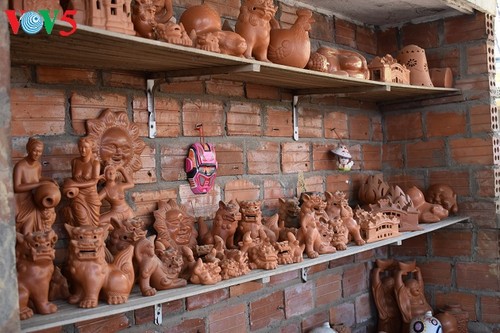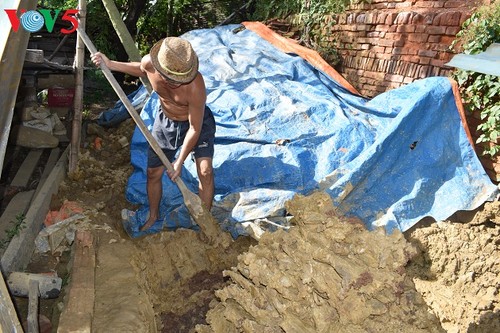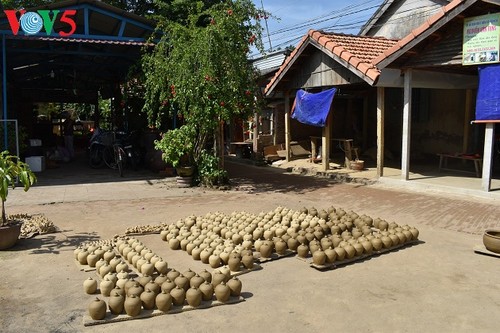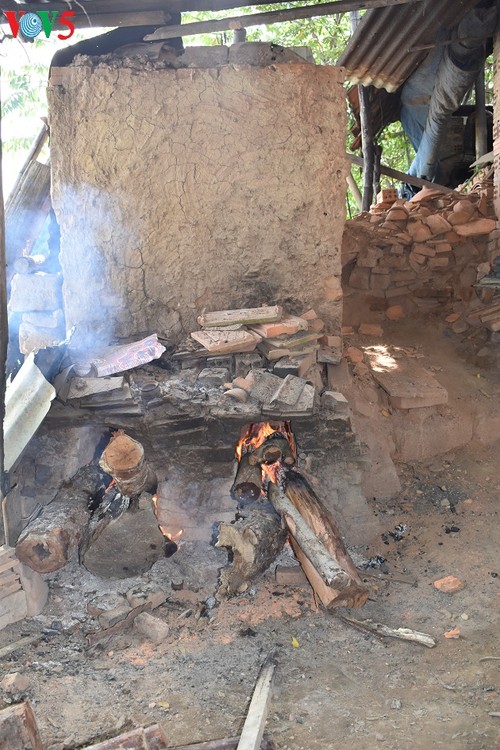|
 Pottery products are displayed at the households in the village. Pottery products are displayed at the households in the village.
(Photo: Lan Anh)
|
Arriving at Thanh Ha pottery village, visitors are first impressed by the village’s brick-paved roads and houses roofed with tiles made by local potters.
Shops huddled close together display all kinds of Thanh Ha pottery from fine art pieces to items meant for daily use. The village is always crowded with visitors to explore the traditional craft.
Tho Ha village in Bac Giang province makes pottery from green clay. Hanoi’s Bat Trang village makes pottery from white clay. And Phu Lang village in Bac Ninh province makes pottery from yellow clay. In Thanh Ha village potters use a brown clay of high viscidity and adhesion taken from the Thu Bon River.
The soil is mixed and kneaded until it is as soft and smooth as cake flour.
 Processing clay is the most time-consuming part of making a pottery product (Photo: Lan Anh) Processing clay is the most time-consuming part of making a pottery product (Photo: Lan Anh) |
The special techniques that are used to process, shape, and polish the clay make Thanh Ha pottery products extremely durable and shiny. And Thanh Ha pottery is notably lighter than other brands.
Nguyen Thi Bich Tuyen of the Le Duc Tuan pottery workshop, says processing the clay is the most time-consuming part of making a pottery product of any size.
“It takes all day to soften a barrow of clay. The next day it is divided into small pieces and thrashed again and again until it’s smooth. This phase takes 2 or 3 days. It’s necessary to soak the clay. It is then put into a bucket to make it loose using a special machine and then it’s filtered through a net to remove the gravel,” Tuyen said.
Today Thanh Ha potters still use traditional methods. They use their foot to spin the potter’s wheel when shaping a lump of clay.
 The products are dried in direct sunlight. (Photo: Lan Anh) The products are dried in direct sunlight. (Photo: Lan Anh) |
Nguyen Van Ngu, a senior potter, says most Thanh Ha villagers know how to make pottery but it takes many years to become a master.
Ngu recalled “When I was little, I used to watch my grandparents make pottery and learned each step by heart. When I grew up, I could do the work because I had studied the techniques. The traditional method of spinning the wheel by foot is still being used. One person spins the wheel while another shapes the item. The two must coordinate with each other smoothly.”
After being shaped, the product is dried in direct sunlight before undergoing the furnacing process. Depending on the product, furnacing can take 1 to 3 days.
 A kiln in Thanh Ha Pottery Village. (Photo: Lan Anh) A kiln in Thanh Ha Pottery Village. (Photo: Lan Anh) |
According to Ngu, “Each kiln accommodates about 500 pieces, which are baked for 15 hours. To produce beautiful products, the temperature must be properly adjusted. As a veteran potter, I know whether or not the flame is hot enough.”
As they shape the clay and polish the final product, the potters inject their soul into their work.
Le Thi Hien Tran, one of Thanh Ha village’s junior potters, said: “We are proud of the diversity of eye-catching products produced by our traditional craft. I’ve made many different kinds of products, including the traditional Vietnamese children’s toys called “tò he” and animals based on famous cartoons. My mom shapes the products and I decorate them. We manage to find ways to make our products attractive to customers.”